Bulletin – September 2011 China's Labour Market
- Download the article 705KB
Abstract
This article discusses some of the key characteristics of China's labour market, including the role of the changing demographic structure, the nature and composition of employment, as well as the important role of the country's rural migrant workforce.
Introduction
The reforms in China over the past 30 years have transformed the nature of employment in the world's most populous country. The ‘iron-rice bowl’, whereby urban workers were guaranteed a job in the state sector (state- and collective-owned enterprises), has been effectively dismantled, while other reforms have opened the economy and allowed rapid growth in a range of industries. These developments, as well as increased labour mobility, have resulted in a massive expansion in the employment of rural migrants – workers whose residence is rural but who typically move to the city for much of the year for employment opportunities. This has expanded the pool of labour available to China's construction and manufacturing sectors, amongst others, and helped China's economy to grow. This article discusses these developments, paying particular attention to: the nature of employment in China; the role of rural migrant workers; and some of the demographic challenges that China will confront over the coming decades.
Some Basic Demographic Facts
According to preliminary statistics from China's latest census, China's mainland population reached 1.34 billion people in 2010, with the population having grown at an annual average rate of 0.6 per cent over the past decade – down from 1.0 per cent over the previous decade. This slowing in the rate of population growth is significant, and ongoing changes to the age structure in China will have important implications for China's labour market.
The working-age population (ages 15–64) increased to 74½ per cent of China's population in 2010 (from around 70 per cent in 2000), reflecting a significant reduction in the share of the population below the age of 15 (Graph 1). As a result, the dependency ratio (defined as the ratio of the population aged 0–14 or 65 and over to the working-age population) has declined to a very low level by international standards. United Nations (UN) projections of China's population suggest that the working-age population will peak within the next five years and subsequently will begin to shrink, while the dependency ratio is expected to rise rapidly as the population ages.[1]
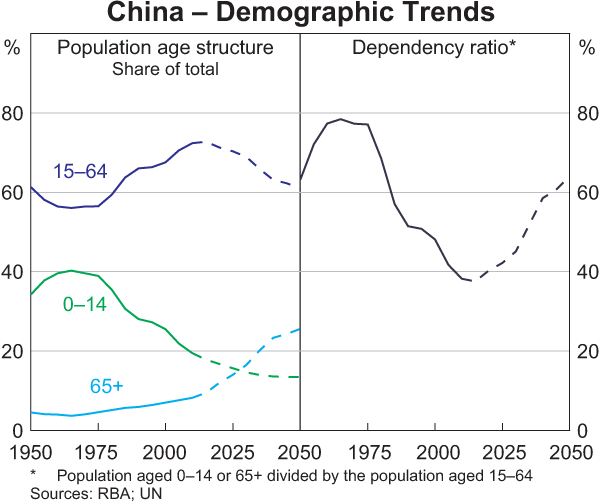
One of the other significant ongoing changes in China has been the urbanisation of the population. Over the past decade, the share of the population living in an urban area increased by 13 percentage points to 50 per cent. In 2010, around 220 million people lived in a location different from that of their official household registration, an increase of over 80 per cent from 2000. As discussed later in this article, this reflects the rapid expansion in the number of rural migrant workers, with some estimates suggesting that there were as many as 100 million rural migrants living and working in urban centres during 2010.
There has also been a rapid shift towards urban employment, with the share of workers employed in urban areas increasing from just over 20 per cent in the late 1970s to 40 per cent by 2009 (Graph 2). The difference between the share of urban employment (40 per cent) and the urbanisation rate (50 per cent) is accounted for by different participation rates in rural and urban areas: although there is probably significant underemployment in rural areas, employment data suggest that just over 65 per cent of the rural population is employed compared with around 50 per cent in urban areas.
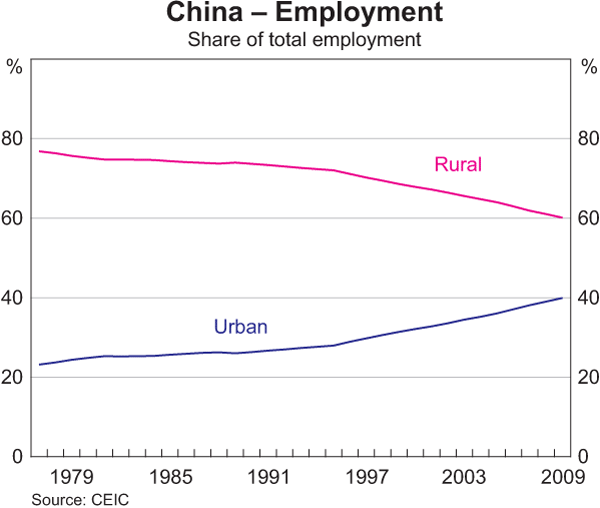
The urban participation rate (including rural migrant workers) is currently estimated to be a little over 60 per cent and has fallen over the past 10 years (Graph 3). There are a couple of potential reasons for this fall. The first is the rising enrolment rate in tertiary education; the number of new undergraduate enrolments increased six-fold between 1998 and 2009. The second is the relatively low retirement age in China, coupled with an increase in the share of the population between the ages of 50 and 64. Official retirement ages are 60 for males and 50–55 for females, and Knight, Quheng and Shi (2010) report that in 2002 the actual median retirement age was 59 for males and 51 for females. Notwithstanding the fall in the participation rate, urban employment growth has been rapid over the past decade reflecting the strong growth of the Chinese economy.
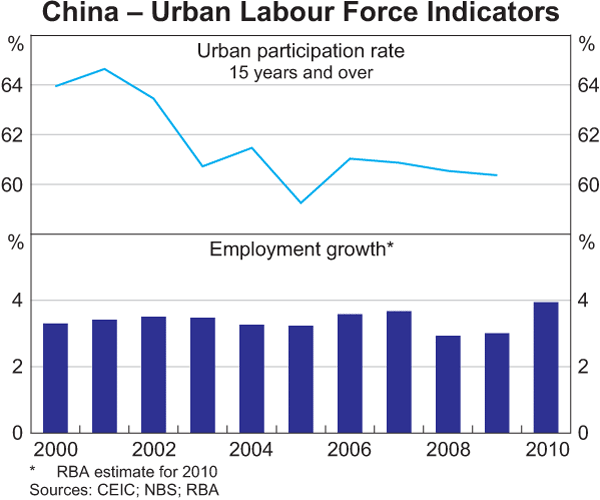
Employment Patterns
Economic reforms over the past three decades have seen a major shift in the ownership structure of employing firms (Graph 4). The share of urban employment attributed to state- and collective-owned enterprises (SOE and COE) has fallen from more than 90 per cent of employment in 1990 to 30 per cent in 2010.
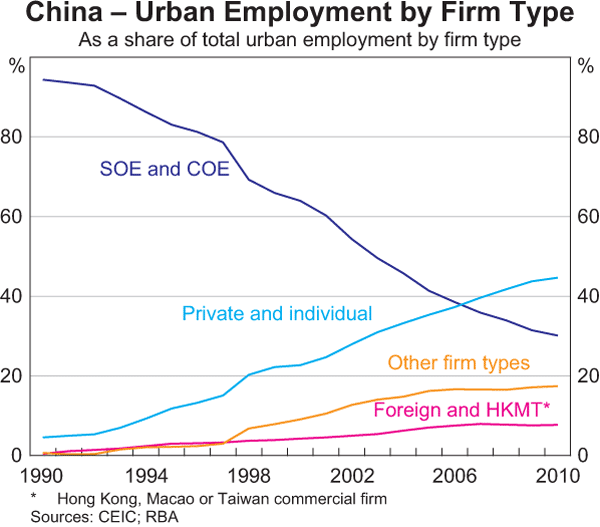
By the early 1990s, it had become widely apparent that staffing levels in many SOEs were considerably above what was required. A survey in the mid 1990s by the National Bureau of Statistics of China (NBS) across 13 provincial capital cities suggested that 15 to 30 per cent of ‘employed’ workers in SOEs were effectively redundant (Kai 1995). By 1996, more than a third of SOEs were operating at a loss. To address overstaffing and low productivity in SOEs, the Chinese Government initiated a limited program of state-sector lay-offs in 1994 that was made national in 1997 (the xiagang reform). Under the xiagang reform, some laid-off workers were granted early retirement and early access to SOE pension schemes, while others were laid off with severance pay for a period of time, the size and duration of which depended on the worker's salary, years of service, the nature of their job and other working conditions. Between 1995 and 2002, the state-sector restructuring led to 36 million state-sector workers being laid off (Giles, Park and Zhang 2005), with employment in SOEs declining by a similar magnitude.
Over the past decade, employment growth in the ‘non-state’ sector has been very strong, with employment in these firms expanding by over 110 million persons.[2] The shift in employment away from SOEs and COEs to other firm types has been strongest in the eastern provinces.
Employment in non-state firms is concentrated within a few key industries, with manufacturing and wholesale & retail trade each accounting for 20 per cent of urban firm employment (Graph 5). Employment in the state sector is skewed towards social services; about half of urban state-sector employees work in the education, health, social security & social welfare, and ‘public management & social organisation' industries, while just over 5 per cent of state-sector employment is in the manufacturing sector.
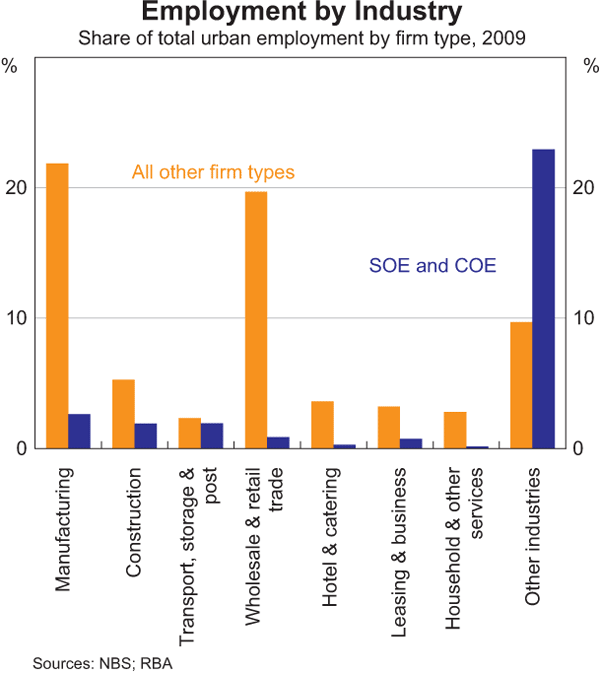
Recent Trends in Wages
Data from the NBS suggest the average annual urban pre-tax wage was around CNY 30,000 in 2010 (which is equivalent to about A$90–95 per week; Table 1). Despite widely publicised minimum wage freezes in 2009, average wages grew at an annual rate of 12 per cent between 2008 and 2010. The largest increases in wages were recorded in COEs, with wages in SOEs also increasing by more than average; non-state firms, which pay lower wages on average, increased wages by about 11 per cent per year over this period.
| Nominal wages
CNY '000 2010 |
Average annual growth
Per cent 2008–2010 |
|
|---|---|---|
| Average | 29.8 | 11.7 |
| By ownership | ||
| SOE | 39.5 | 12.8 |
| COE | 24.4 | 15.4 |
| Non state- or collective-owned | 26.2 | 11.0 |
| of which | ||
| Limited liability | 33.1 | 12.1 |
| Shareholding | 46.0 | 14.1 |
| Foreign-owned | 40.2 | 10.9 |
| HKMT | 31.4 | 11.4 |
| Private | 20.8 | 10.3 |
| Sources: NBS; RBA | ||
Wages for privately owned firms are currently around 30 per cent lower than the national average while wages paid by SOEs are about 30 per cent higher; this gap has widened over the past decade (Graph 6). Lower non-state sector wages do not seem to reflect employment patterns across regions, with data from official sources suggesting that the gap between state and non-state sector wages is broadly similar across provinces and also industries (Graph 7).
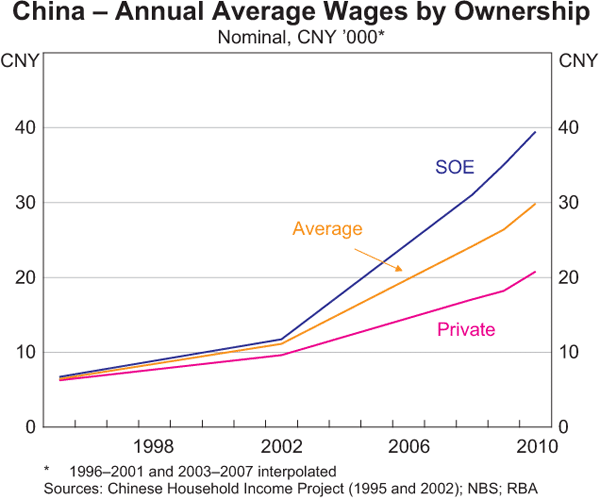
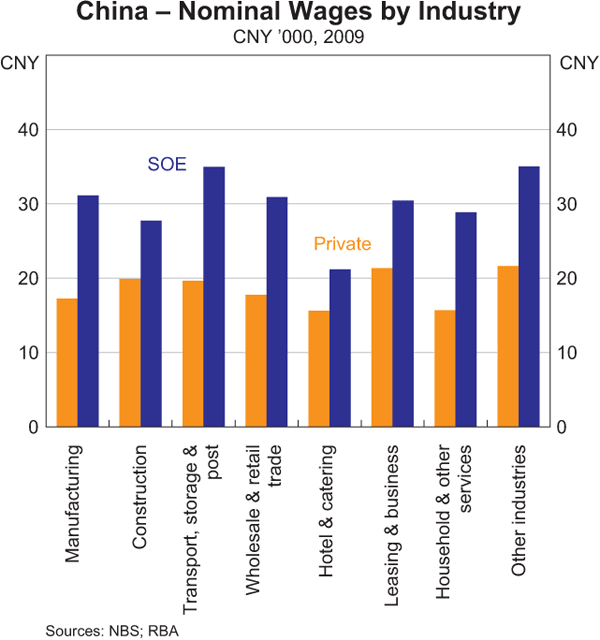
There are a number of possible explanations for the gap between state and non-state sector wages. Chen, Lu and Sato (2010) have argued that factors such as Communist Party membership and household registration represent labour market barriers that generate wage differentials. A further possibility is that the wage gap is explained by differences in human capital or hours worked. However, Démurger, Shi and Yang (forthcoming) argue that the wage premium enjoyed by employees of state-owned firms cannot be entirely accounted for by these factors. Another explanation is the potential role of rural migrant workers in driving wage differentials between the state and non-state sectors, and across industries.
Rural–urban Migration
An important trend in China's labour market over the past few decades has been the rapid growth in the number of rural migrants working in urban enterprises (Graph 8). Prior to the late 1970s, the state's monopoly control of the distribution of living necessities and urban employment made it difficult for rural citizens to migrate to cities. The hukou system (or household registration system) classified people by their place of residence, and whether they were deemed to have ‘rural’ or ‘urban’ status. Under the food rationing system, a person was only eligible to receive staple foods if they remained in their local hukou area (Chan and Zhang 1999). While the food rationing system was subsequently abolished, the hukou system remains in place. In general, it is difficult for a person with rural household registration to migrate permanently and receive an urban household registration. Although labour mobility has improved over the past few decades, the hukou system still provides significant barriers to internal migration. In particular, since only those people who have local hukou registration are allowed to access most welfare services provided by the government, such as health care and education services, rural migrants are excluded from accessing these services.
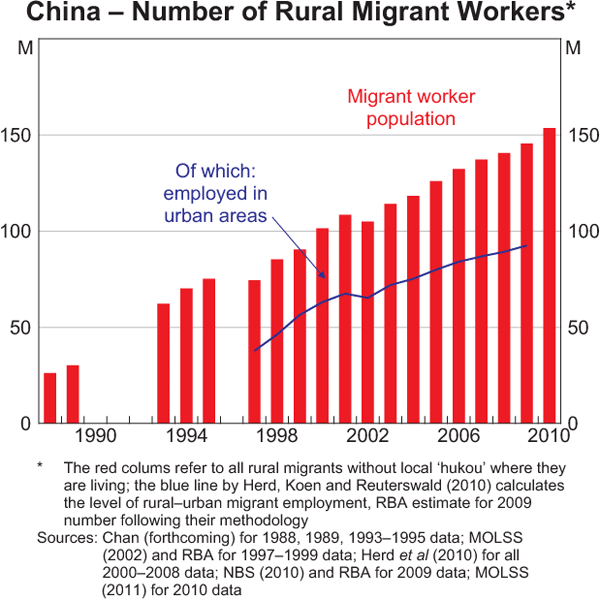
Agricultural reforms that boosted farm productivity, combined with a baby boom in the 1950s and migration restrictions, led to significant surplus labour in rural areas by the 1980s (Li, Liu and Zhang 2003). The initial response of the Chinese Government was to encourage the development of rural industry through township and village enterprises (TVEs). By the end of the 1980s, around 95 million workers were employed in TVEs.
In 1985, the Ministry of Public Security introduced a new system of temporary residency for people outside their place of hukou registration. The change promoted the internal migration of rural workers, whereas the previous policy required work by rural labourers in cities to be formally pre-arranged (Chan and Zhang 1999). The change of policy resulted in a rapid expansion in the migration of rural workers to urban centres – by 1989, the number of rural migrant workers was estimated to have reached 30 million, up from only 2 million in the early 1980s.
A further impetus to migration came from Deng Xiaoping's southern inspection tour in 1992, which precipitated a wave of investment and development in China that, in turn, led to rapid growth in the demand for labour in the southern coastal areas. Combined with the development of the private sector, the dismantling of the food rationing system from the mid 1980s and the relaxation of restrictions on internal migration, this helped to encourage rapid growth in the number of rural migrant workers – by 1993, the number of rural migrant workers had reached over 60 million. However, the lay-offs precipitated by the xiagang reform led to the emergence of urban unemployment by the late 1990s, causing some local governments to impose regulations to restrict rural migration (Zhan 2005). Coupled with the effects of the Asian financial crisis, migration slowed in the mid to late 1990s.
Rural–urban migration expanded again through the 2000s as the opening of China's economy was accelerated following its accession to the World Trade Organization in 2001. Overall, the economic reforms that began in the late 1970s and the relaxation of certain aspects of the hukou system greatly increased the migration of labour from rural to urban areas; there has been a rough doubling in the number of rural migrant workers over the decade to its current level of just over 150 million.
In 2010, there were a little over 240 million people with a rural hukou not working in agriculture, equivalent to about 30 per cent of the country's labour force. A little over 60 per cent of these workers had migrated, with the remainder staying in their local area – for example, to work for a TVE. Of the rural migrants, around half have migrated to another province. Comprehensive data on inter-provincial migrant worker flows for the period 2000–2005 suggest that the source provinces of inter-provincial migrants are concentrated in the centre and south-west of China – particularly Sichuan and Anhui (Figure 1) – while roughly half of inter-provincial migrants move to the coastal provinces of Guangdong and Zhejiang – where a large amount of manufacturing activity occurs (Figure 2). Given the strong demand for labour along the coastal provinces, rural migrants from eastern provinces are less likely to migrate to another province. NBS data for 2009 suggest that migrants from eastern provinces are about four times as likely to migrate within their home province as to migrate to another province. On the other hand, migrants from the central and western provinces are more likely to migrate to another province than stay in their home province.
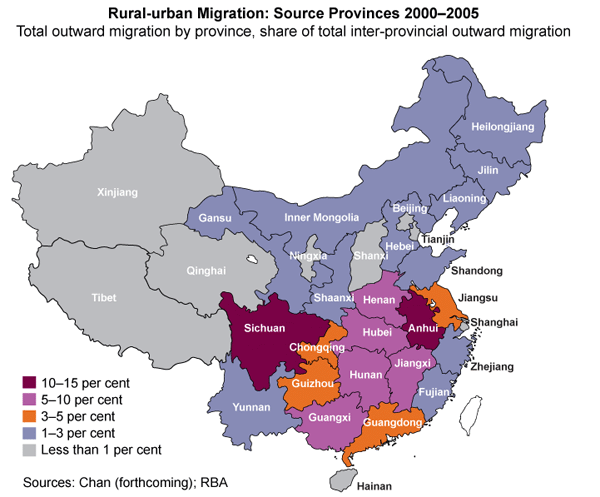

While the eastern provinces are still the major destination for migrant workers, there appears to have been a shift in migrant labour away from these coastal regions between 2008 and 2009. This shift is most evident in the Pearl and Yangtze River Delta areas, which absorbed 52 per cent of all migrant labour in 2008, but only 42 per cent in 2009. This was partly due to the economic effects of the global financial crisis deterring migration towards the coast, but it could also reflect the gradual shift in economic activity towards the central and western provinces as central government policies increasingly focus on developing these regions further.
Reflecting the large share of rural migrants in coastal provinces, it appears that migrant workers are predominantly employed by the non-state sector and, in particular, by the manufacturing industry (Graphs 9 and 10). Nearly 70 per cent of migrant workers are employed in ‘private and individual’ firms, although this share appears to have declined over the past 10 years. Currently, rural migrants are estimated to account for a little over half of urban employment in private and individual firms.
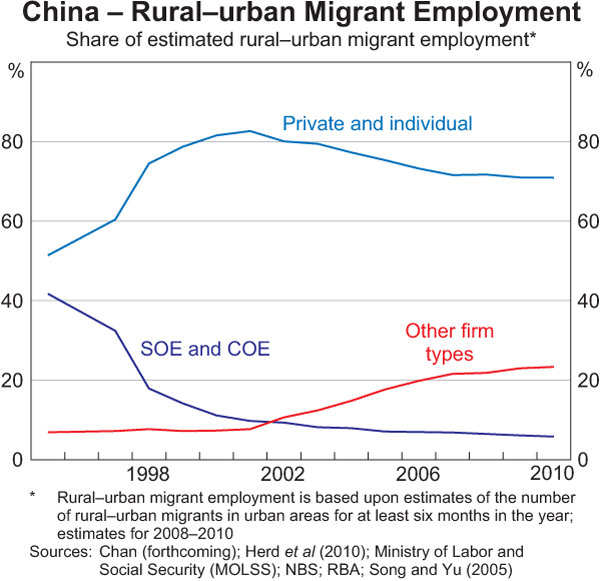

Given that migrant workers constitute a far larger share of non-state sector employment than of state sector employment, it seems plausible that rural–urban migration might be playing a role in driving the wage differentials between these sectors noted earlier. Wages for migrant workers tend to be a lot lower than average urban wages. In 2009, the average migrant earned about CNY 1,700 per month for those months that they worked (equivalent to around A$60 a week; Graph 11).[3] These workers typically spend a portion of the year in their home towns and villages. They also typically work long hours; the average migrant worked 58½ hours a week in 2009, compared with the urban average of a little less than 45 hours a week in November 2009.
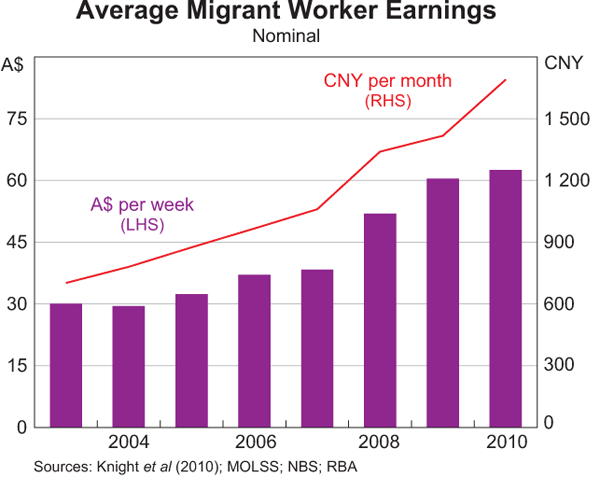
One reason for the relatively lower wages of migrant workers is that they typically have lower levels of education (Graph 12). In 2009, less than one quarter of migrants had completed high school and only 10 per cent had tertiary qualifications of awny kind. By comparison, 70 per cent of registered urban job seekers had completed high school, with 30 per cent having earned a tertiary qualification.
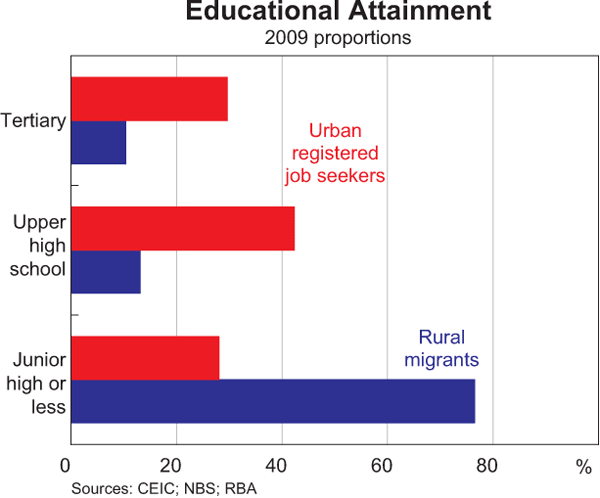
The Effect of Demographic Change on China and Surplus Rural Labour
According to the 2010 revision of the UN's World Population Prospects, the working-age population in China is expected to peak in the next five years or so and shrink by 20 per cent by 2050, under the UN's central fertility assumptions. The effects of such a demographic shift on the labour force may, however, be partly offset by an increase in the participation rate through later retirements. With fewer children to help support parents in their retirement and limited financial support from public pensions, it would not be surprising if there was a trend for workers to retire later. The effect on the urban labour market may also be offset by a further expansion in the number of rural migrant workers in coming years. However, there is much debate as to how much rural ‘surplus’ labour remains.
Some contend that China is close to exhausting its surplus of rural labour. Such arguments are often predicated on reports of rapid wage increases in recent years for migrant workers, which could signal a tightening of rural labour supply.[4] While there have been media reports of migrant worker shortages in coastal urban areas since at least 2003, the frequency of such reports appears to have increased recently.
Others have argued that China still has a large stock of surplus rural labour. Using detailed survey data, Golley and Meng (forthcoming) show that over the past decade wages for rural migrant workers have grown at half the rate of wages for workers with an urban hukou, suggesting that factors such as experience, the level of education and living costs could explain increases in normal migrant worker wages. Furthermore, Knight et al (2010) argue that institutional factors, particularly those that prevent rural migrants from accessing most welfare services provided by the Government, deter migration, and consequently there remains a large pool of potential migrant workers. Consequently, these authors claim that despite a dramatic increase in migration over the past two decades, the number of rural migrants could increase further. Using alternative sets of assumptions, both Knight et al (2010) and Golley and Meng (forthcoming) suggest that an increase of roughly 150 million migrants by 2020 – that is, a doubling of the current level – is possible.
Footnotes
The author is from Economic Group. [*]
See Hall and Stone (2010) for a detailed discussion of population trends in China. [1]
A portion of the growth in non-state sector employment could, however, be attributed to the reclassification of some SOEs as limited liability companies despite the government retaining control of these companies (OECD 2000, pp 17–18). Unfortunately, the official NBS data do not allow employment in ‘other firms’ to be split by state- and non-state ownership. For a discussion of ownership structure across different ownership types, see ADB (2002). [2]
However, in 2009 around 50 per cent of rural migrants received free accommodation from their employers. Free or subsidised accommodation is not captured in the wages data, potentially understating the true level of remuneration to migrant workers. [3]
Other arguments have been made; see Golley and Meng (forthcoming) for a synopsis. [4]
References
ADB (Asian Development Bank) (2002), ‘The Development of Private Enterprise in the People's Republic of China’, Asian Development Bank. Available at <http://www.adb.org/Documents/Reports/TAR3543/>.
Chan K (forthcoming), ‘China, Internal Migration’, in Ness I and
P Bellwood (eds), The Encyclopaedia of Global Migration, Blackwell Publishing. Available
at
<http://faculty.washington.edu/kwchan/Chan-migration.pdf>.
Chan K and L Zhang (1999), ‘The Hukou System and Rural–Urban Migration in China: Processes and Changes’, The China Quarterly, 160, pp 818–855.
Chen Z, M Lu and H Sato (2010), ‘Social Networks and Labor Market Entry Barriers: Understanding Inter-industrial Wage Differentials in Urban China’, Institute for Research on Labor and Employment Working Paper No 2010–09.
Démurger S, L Shi and J Yang (forthcoming), ‘Earnings Differentials Between the Public and the Private Sectors in China: Explaining Changing Trends for Urban Locals in the 2000s’, China Economic Review. Available at <http://dx.doi.org/10.1016/j.chieco.2011.08.007>.
Giles J, A Park and J Zhang (2005), ‘What is China's True Unemployment Rate?’, China Economic Review, 16(2), pp 149–170.
Golley J and Meng X (forthcoming), ‘Has China Run Out of Surplus Labour?’, China Economic Review. Available at <http://dx.doi.org/10.1016/j.chieco.2011.07.006>.
Hall J and A Stone (2010), ‘Demography and Growth’, RBA Bulletin, June, pp 15–23.
Herd R, V Koen and A Reutersward (2010), ‘China's Labour Market in Transition: Job Creation, Migration and Regulation’, OECD Economics Department Working Paper No 749.
Kai Z (1995), ‘Unemployment in China is Worsening’, October Review, 22(4). Available at <http://www.hartford-hwp.com/archives/55/369.html>.
Knight J, D Quheng and L Shi (2010), ‘The Puzzle of Migrant Labour Shortage and the Rural Labour Surplus in China’, The University of Oxford, Department of Economics Discussion Paper Series No 494. Available at <http://economics.ouls.ox.ac.uk/14813/1/paper494.pdf>.
Li X, S Liu and M Zhang (2003), ‘Scenario Analysis on Urbanization and Rural–Urban Migration in China’, International Institute for Applied Systems Analysis Interim Report IR-03-036. Available at <http://www.iiasa.ac.at/Admin/PUB/Documents/IR-03-036.pdf>.
MOLSS (Ministry of Labour and Social Security)(2002),
‘![]() ’ (The 2000 China Rural Labour
Force Employment and Migration Conditions), 2 September.
’ (The 2000 China Rural Labour
Force Employment and Migration Conditions), 2 September.
Available at <http://www.lm.gov.cn/gb/data/2002-09/02/content_3464.htm>.
MOLSS (2011), ‘![]() ’ (For the 242 Million Migrant Workers'
Welfare: Analysis of Migrant Worker Employment), 25 March. Available at
<http://www.chinajob.gov.cn/DataAnalysis/content/2011-03/25/content_623260.htm>.
’ (For the 242 Million Migrant Workers'
Welfare: Analysis of Migrant Worker Employment), 25 March. Available at
<http://www.chinajob.gov.cn/DataAnalysis/content/2011-03/25/content_623260.htm>.
NBS (National Bureau of Statistics of China) (2010), ‘![]() ’ (2009 Monitoring Report of Migrant
Workers). Available at
<http://www.stats.gov.cn/tjfx/fxbg/t20100319_402628281.htm>.
’ (2009 Monitoring Report of Migrant
Workers). Available at
<http://www.stats.gov.cn/tjfx/fxbg/t20100319_402628281.htm>.
OECD (Organisation for Economic Co-operation and Development) (2000), Reforming China's Enterprises, China in the Global Economy, OECD, Paris.
Riskin C, Z Renwei and L Shi (2010), ‘Chinese Household Income Project, 1995’, Inter-university Consortium for Political and Social Research, University of Michigan.
Shi L (2009), ‘Chinese Household Income Project, 2002’, Inter-university Consortium for Political and Social Research, University of Michigan.
Song L and S Yu (2005), ‘Rapid Urbanisation and Implications for Growth in China’, in R Garnaut and L Song (eds), The China Boom and its Discontents, ANU E Press and Asia Pacific Press, Canberra, pp 105–127.
UN (United Nations) (2009), World Population Prospects: The 2010 Revision – Highlights, United Nations, New York.
Zhan S (2005), ‘Rural Labour Migration in China: Challenges for Policies’, United Nations Educational, Scientific and Cultural Organisation, Management of Social Transformations Policy Papers No 10.